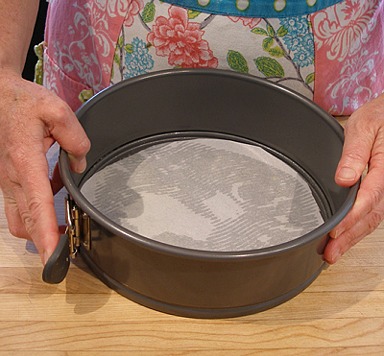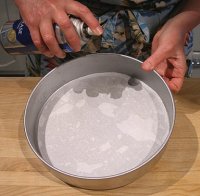 Properly preparing your baking pans is one of the important keys to successful baking. Generally, the way in which they are prepared varies by the type of recipe–you can use oil, butter, clarified butter, shortening or pan spray, and so on. SHORTENED (BUTTER) CAKES generally tend to have their cake pans greased so the baking recipe won't stick; the amount of coverage dependant upon the amount of fat in the recipe. Some UNSHORTENED (FOAM) CAKE pans are not prepared in advance and remain ungreased, such as for Angel Food Cakes.
Properly preparing your baking pans is one of the important keys to successful baking. Generally, the way in which they are prepared varies by the type of recipe–you can use oil, butter, clarified butter, shortening or pan spray, and so on. SHORTENED (BUTTER) CAKES generally tend to have their cake pans greased so the baking recipe won't stick; the amount of coverage dependant upon the amount of fat in the recipe. Some UNSHORTENED (FOAM) CAKE pans are not prepared in advance and remain ungreased, such as for Angel Food Cakes.
SARAH SAYS: Make sure you do not use nonstick pans for foam type cakes; these types of batters need to literally climb up the pan's surface to rise and the grease or nonstick coatings makes it too slippery for them to do so. Also fat deflates delicate egg white foams.
This how to baking technique is used with the Ultimate Butter Cake (UBC) Recipe.
Always prepare the baking pan(s) and put them aside before you mix the recipe's ingredients — for best results, all batters must be placed in their “prepared pans” and baked right away after mixing, unless the recipe specifies otherwise. This is especially true when making delicate batters such as UNSHORTENED (FOAM) CAKES as they can deflate easily. Recipes made with baking soda and baking powder, such as SHORTENED (BUTTER) CAKES, also need to be baked right away after mixing. They release their leavening power as soon as they are moistened when the ingredients mixed; if the batter sits around before baking, you have a good chance for a flat, dense and flavorless cake.
Bakeware should be cleaned with soap and water as soon as possible after baking to remove any residue which may be present.
QUESTION: Sometimes a recipe will just say “prepare the pan” or “use a prepared pan”, what does that mean?
SARAH SAYS: It means that you put some sort of coating on it so the batter or dough won't stick when baked, making the baked good easy to remove afterwards.
| BUTTER – SOFTENED OR MELTED | Great taste. Makes a dark, crustier crust. Can burn. Cakes tend to stick more readily when used. |
| CLARIFIED BUTTER OR GHEE | No taste. High smoking point. Preferred to just using butter. |
| VEGETABLE OIL PAN SPRAY |
Quick and easy |
| SHORTENING | Does not burn easily Imparts no taste Preferred by most bakers |
| PROFESSIONAL BAKER'S GREASE Equal parts of Crisco shortening, oil, and flour. |
It is usually sold in cake supply stores, but you can mix your own. Mix ingredients in a mixer with a beater attachment, until light and fluffy. Use a pastry brush to apply the grease on the inside of your pan No need to follow up with a flour sprinkling. Store it in an airtight container in the refrigerator. |
| BREAD CRUMBS | From Maida Heatter’s Cakes: Butter the pan (nonstick or not), getting into all of the fluted parts and including the center tube. Then dust the entire buttered surface with fine, dry bread crumbs (the kind you can buy in a cardboard can at the supermarket or you can make yourself). Include the center tube in the dusting, too, by turning the pan on its side and slowly rotating it while you drizzle crumbs on the tube from your fingers. Invert the pan and shake out excess crumbs. Then fill and bake; when you turn the pan over, the whole cake drops right out, pretty as you please. |
| FLOUR AND/OR COCOA POWDER (for chocolate cakes) |
For extra insurance, a flour coating is used, especially with thin batters or those made with chocolate, fruits and nuts. These batters are notoriously sticky and need the flour to keep the caramelized sugars from sticking to the pans. Flour also creates a barrier between the butter from the pan and the batter to prevent the butter from melting into the batter. When baking a chocolate cake, use a mixture of 1/3 part flour and 2/3 part cocoa powder (sift together) so it won't show on the sides of the layers when unmolded. You’ll need to sprinkle about 2 tablespoons of flour or a mixture of flour and cocoa inside an 8- or 9-inch cake pan and shake to coat all greased surfaces. Use a strainer when applying cocoa powder because it doesn't act like flour does; it easily sticks and clumps in the pan. To do, hold the strainer over the pan and sprinkle cocoa all over. Turn pan upside down to tap out the excess. |
| PARCHMENT OR WAXED PAPER | I prefer to use parchment paper versus waxed paper to line pans. To make a good fit, place pan on top of parchment paper, trace around the pan and cut it out. Fit it to an already greased pan and grease again. Waxed paper doesn't hold up as well; it gets soggy when used in the bottom of cake or loaf pans. Waxed paper cannot be used to line cookie sheets with as exposed areas smoke or burn in the oven. Use aluminum foil, instead. |
| FOIL SLING | Make a sling for a loaf or brownies by laying long, wide strips of foil or even parchment paper across the length and width of the pan so the paper hangs over the edges. They work the best if you make the paper the same width as the pan where it will be used. Use the overlap as a handy grip when its time to remove the loaf from the pan. |
| TYPE | COMMENTS |
| CAKES: | |
| Shortened (Butter) Cakes | Grease pans. Lining with greased parchment paper is a big plus. |
| Unshortened (Foam) Cakes | Do NOT use nonstick pans. Not generally greased because fat can deflate their delicate foams. Angel Food Cakes – Not greased Cake Rolls (Roulades) – Grease and line with parchment paper or a nonstick liner. Do not grease parchment paper. Chiffon Cakes – Grease the bottom of the cake pan ONLY – DO NOT grease the sides. Genoise Cakes – Generously grease pan, line with greased parchment paper. Meringues – Not greased. Sponge Cakes – Generally, grease only the bottom of the pan, line with greased parchment paper. |
| Bundt Cakes | Cakes tend to stick to these pans. I like to use Professional Baker's Grease so they don't. Or, dust with flour after being liberally greased with shortening (do not use butter, unless clarified). I like to use a pastry brush to spread the grease evenly in the pan. |
| Cake Molds | I like to use Professional Grease. Or, coat them first with a layer of shortening, which works best with molded pans. Then, dust the pan with a sprinkling of flour |
| Cake Mixes | When a cake mix calls for flouring the baking pan, use a bit of the dry cake mix instead, no flour mess on the outside of the cake. Or, spray with vegetable oil spray. |
| Chocolate Cakes | When a cake mix calls for flouring the baking pan, use sifted cocoa powder instead of flour. There's no mess on the outside of the cake. |
| OTHER: | |
| Bread | Read recipe carefully, as some need greased pans while others don't. |
| Cookies | Read recipe carefully, as some need greased pans while others don't. If not sure, lining with parchment paper always works well. |
| Pies | Because there is so much shortening in a piecrust, pans usually need not be greased or floured, unless specified otherwise. Doing so would ruin the recipe. |
| Quick-Breads | Need greased pans. For best results, use a parchment or waxed paper liner in the bottom of the pan. |
HOW TO LINE A BAKING PAN WITH GREASED PARCHMENT PAPER
1. Place one pan on top of a piece of parchment paper and trace around it with a pencil. The lead is nontoxic.
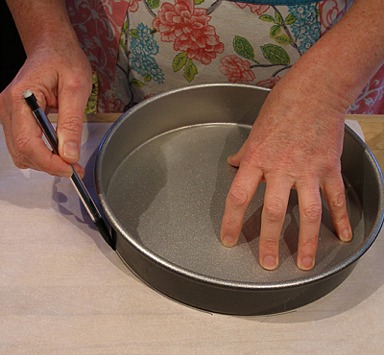
2. Cut out the round of parchment paper following the pencil marks as a guide.
3. Grease the pans with cooking oil spray.
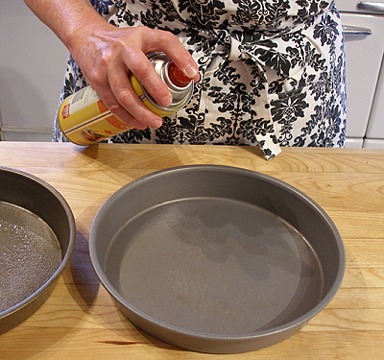
4. Place the parchment paper round in each pan, and grease again. Set pans aside until needed.
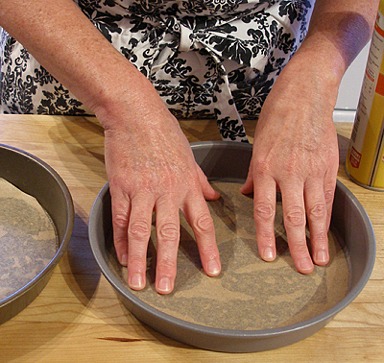
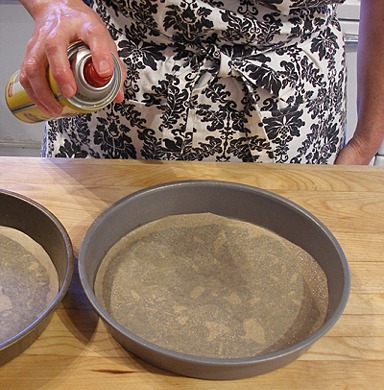
HOW TO LINE A BAKING PAN WITH UNGREASED PARCHMENT PAPER
1. For example, prepare, the jelly-roll pan by first greasing by spraying with nonstick cooking spray.
SARAH SAYS: If using a Silpat, nonstick mat, there's no need to grease the pan first.
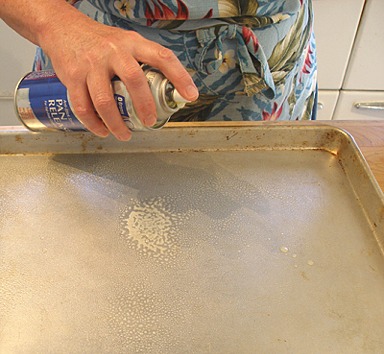
2. Then, line with parchment paper or a nonstick liner. Grease by spraying with nonstick cooking spray.
SARAH SAYS: Silpat mats should not be greased.
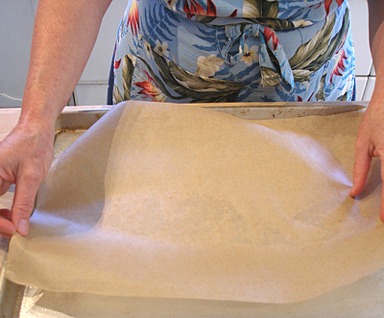
HOW TO LINE A SPRINGFORM PAN WITH GREASED PARCHMENT PAPER
1. To fit a piece of parchment paper to its pan, trace the outline of the pan on a piece of parchment paper. Cut out the circle, and place it pen or pencil side down in the pan.
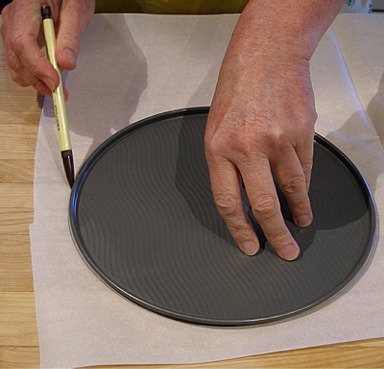
2. Lightly spray the bottom of the springform pan.
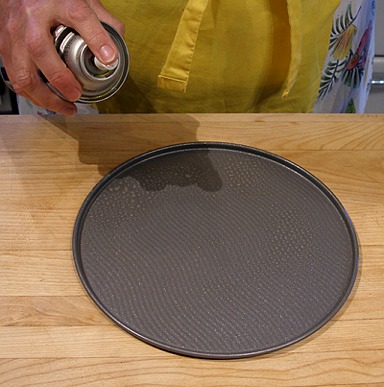
3. Fit the cut-put parchment round to the bottom of the greased springform pan bottom, and lightly spray with oil, again.
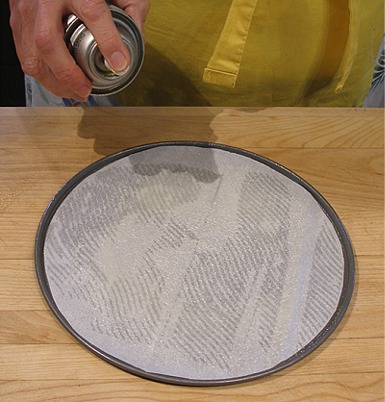
4. Clamp on the springform pan's sides. Grease the sides of the pan IF called for in the recipe.
